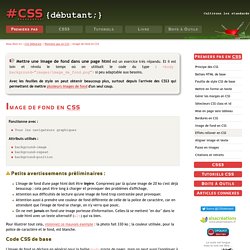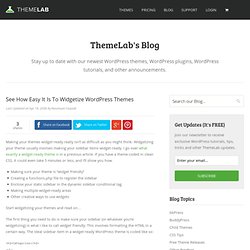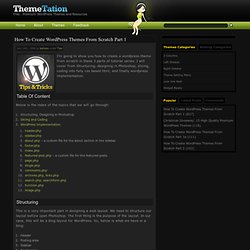

Image de fond en CSS (background-image) dans une page html - CSS Debutant. Mettre une image de fond dans une page html est un exercice très répandu.

Et il est loin et révolu le temps où on utilisait le code du type : <body background="images/image_de_fond.png"> si peu adaptable aux besoins. Avec les feuilles de style on peut obtenir beaucoup plus, surtout depuis l'arrivée des CSS3 qui permettent de mettre plusieurs images de fond d'un seul coup. Fonctionne avec : Tous les navigateurs graphiques Attributs utilisés : background-image background-repeat background-position Petits avertissements préliminaires : L'image de fond d'une page html doit être légère.
Pour illustrer tout cela, visionnez ce mauvais exemple : la photo fait 330 ko ; la couleur utilisée, pour la police de caractère et le fond, est blanche. Code CSS de base L'image de fond se déclare en général pour la balise body (corps de page), mais on peut aussi l'appliquer à un bloc (<div></div>), ou un titre (<hx></hx>), une citation (<blockquote></blockquote>), etc. Visionner l'exemple Fond de page fixe ou : Astuce. Make Your WordPress Theme Widget-Ready Tutorial - See How Easy It Is To Widgetize WordPress Themes. Making your themes widget-ready really isn’t as difficult as you might think.

Widgetizing your theme usually involves making your sidebar items widget-ready. I go over what exactly a widget-ready theme is in a previous article. If you have a theme coded in clean CSS, it could even take 5 minutes or less, and I’ll show you how. Making sure your theme is “widget friendly”Creating a functions.php file to register the sidebarEnclose your static sidebar in the dynamic sidebar conditional tagMaking multiple widget-ready areasOther creative ways to use widgets Start widgetizing your themes and read on… The first thing you need to do is make sure your sidebar (or whatever you’re widgetizing) is what I like to call widget friendly.
<h2>Categories</h2> <ul> <li><a href=" 1</a></li> <li><a href=" 2</a></li> </ul> Notice how this is very clean code. The following four examples are also widgetizable. SMALLIS. How To Create WordPress Themes From Scratch Part 1 » Themetation. I’m going to show you how to create a wordpress theme from scratch in these 3 parts of tutorial series.

I will cover from Structuring, designing in Photoshop, slicing, coding into fully css based html, and finally wordpress implementation. Table Of Content Below is the index of the topics that we will go through: Structuring This is a very important part in designing a web layout. HeaderPosting areaSidebarSingle pageCommentFeedbackSearching fieldPage menuRSSArchives, Links and About Page Something we need to keep in mind. Display too many things in one single page.Use too many colors and font type. In this sample, I also try to make is as simple as possible because the purpose of this series of tutorial is to give an example on how to create a wordpress theme.
Final Result Photoshop Step 1 Create a new document with 1024px X 768px as we are going to create a layout which suit for 1024px resolution. Step 2 Grab the rectangle tool and draw a header for it. Step 3 I use Myriad Pro. Step 4 Step 5. Comment créer un thème Wordpress de zéro.